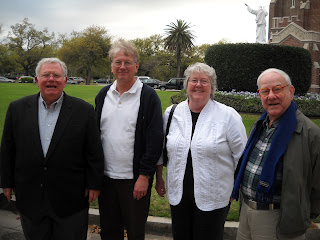 |
| Light Cummins, Steve Webre, Victoria Cummins, and Ray McGowan in New Orleans |
The fifty-fourth annual meeting of the Louisiana Historical Association met in New Orleans this weekend, from March 1 to March 4. Several hundred historians from across the nation attended. A wide variety of sessions dealt with all chronological periods of Louisiana history, along with a number of topics. Vicki Cummins and I both gave papers in a session entitled “Texans on the Waterways of Louisiana History.” Her paper was entitled “Artist Don Brown and the Pelican State Marshall , Texas , where he attended what is now East Texas Baptist College Louisiana . Brown founded the art department at Centenary College in Shreveport and taught there for almost twenty five years. Whether living in Texas or Louisiana , he considered himself primarily a resident of Caddo Lake Caddo Lake Mississippi and Red Rivers Louisiana history and folklore, a subject on which he published in newspapers and magazines. He documented his trips on Louisiana waterways, including a trip down the Mississippi , in addition to writing newspaper articles about the legends of Caddo Lake and the early history of Shreveport . During the final decade of his life, Brown lived at Karnack , Texas Caddo Lake Caddo Lake Texas in the years of initial Anglo-American movement west of the Sabine River . Louisiana waterways were crucial to the settlement of Texas by the Austin family as Louisiana waterways provided pathways into the new province. This paper will examine the activities of the Moses and Stephen F. Austin during the decade prior to the settlement of Texas . During those years, the Austin family lived at Potosi , Missouri Mississippi valley, including the Great River and tributaries such as the Red River . For example, in the years after the War of 1812, Stephen F. Austin superintended lead shipments down the Mississippi to New Orleans . He made one such trip immediately following the spectacular New Madrid earthquakes, leaving a vivid and colorful description of what he witnessed while passing through parts of Louisiana . Then, later in that same decade, Moses and Stephen F. Austin decided to develop the Great Southwestern Trail from Missouri to the Red River as a settlement scheme. Austin lived on a plantation located on the Red River and also founded the town of Fulton , Arkansas New Orleans when he decided to take up the settlement of Texas after the death of his father Moses. New Orleans thus became one of the main departure points for the settlement of Texas from the mouth of the Mississippi to the first settlement of Velasco on the Texas coast. I was elected Vice President of the Louisiana Historical Association at its business meeting.